Generative AI content creation is revolutionizing the way businesses and creators produce digital content. From AI-written articles to AI-generated visuals and videos, this technology is reshaping creativity, productivity, and personalization across industries. In this blog, we will explore how generative AI content creation is changing the landscape, its benefits, tools, challenges, and future trends.
Generative AI doesn’t just help produce content—it augments human creativity, streamlines workflow, and opens up new opportunities in digital marketing, advertising, and entertainment. For example, tools like ChatGPT can draft complete articles in minutes, while platforms like DALL·E and MidJourney generate high-quality images tailored for marketing campaigns.
This blog explores how Generative AI is changing content creation in detail, covering everything from fundamental concepts to practical applications, challenges, and the future of AI in creative industries. Each section is designed to give readers actionable insights, making it a comprehensive guide for anyone interested in AI-driven content creation.
What is Generative AI Content Creation?
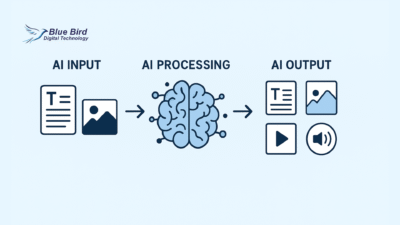
Generative AI Input Processing Output
Generative AI is a branch of artificial intelligence that focuses on creating new data rather than just analyzing existing information. Unlike traditional AI that identifies patterns or makes predictions, Generative AI produces content autonomously. It can generate text, images, audio, video, and even code based on patterns it learns from vast datasets.
How Generative AI Works:
-
Deep Learning Models: Uses neural networks, often transformers, trained on billions of data points.
-
Pattern Recognition: Learns from existing datasets to understand structure, style, and context.
-
Content Generation: Produces coherent and contextually relevant outputs—e.g., an AI can write a blog post or generate a realistic image from a text prompt.
Popular Models and Technologies:
-
GPT Series (OpenAI): Text generation and conversation AI.
-
DALL·E and MidJourney: AI image creation based on textual prompts.
-
Stable Diffusion: Open-source image generation.
-
DeepMind & Google’s Imagen: Advanced AI for multimodal content creation.
Applications of Generative AI:
-
Text: Blog posts, scripts, marketing copy, social media posts.
-
Images: Website visuals, social media graphics, ads.
-
Video: AI-generated avatars, deepfake videos, marketing videos.
-
Audio: Music creation, voiceovers, podcasts.
Impact on Creativity:
Generative AI acts as a collaborative tool. Human creators can guide AI outputs, enhancing efficiency and innovation. For instance, a marketing team might input brand guidelines and let AI generate multiple ad copy variations in minutes—a task that traditionally takes days.
The Rise of Generative AI Content Creation
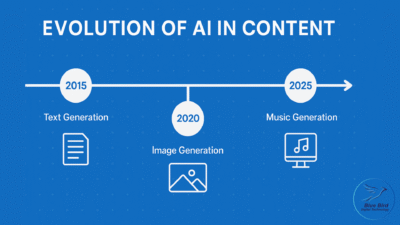
Evolution of AI in Content
The growth of Generative AI is fueled by the demand for faster, scalable, and personalized content. As digital platforms expand, businesses require large volumes of content without compromising quality. AI tools are now essential for brands to maintain competitiveness.
Why AI is Becoming Popular:
-
Speed: AI produces content in minutes rather than hours or days.
-
Scalability: Large brands can generate hundreds of pieces of content simultaneously.
-
Cost Efficiency: Reduces the need for large content teams.
-
Personalization: Delivers targeted content for different audiences.
Real-World Examples:
-
Netflix: Uses AI to generate personalized recommendations and thumbnails.
-
The Washington Post: Uses AI to write news summaries and sports recaps.
-
HubSpot & Jasper AI: Automates marketing copy and social media campaigns.
Industries Benefiting:
-
Digital Marketing: AI writes SEO-optimized blogs, ad copy, and email campaigns.
-
E-commerce: AI generates product descriptions and personalized emails.
-
Entertainment: AI assists in scriptwriting, storyboarding, and video content.
-
Education: AI generates study materials, summaries, and interactive content.
Key Benefits of Generative AI Content Creation for Creators
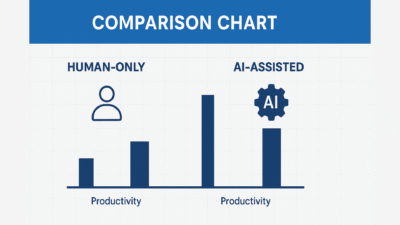
Comparison Chart of Human VS AI-Assisted Content Creation Productivity
Generative AI offers multiple advantages that transform the content creation workflow. Here’s a deep dive:
a. Boost Productivity with Generative AI Content Creation
AI automates repetitive tasks, such as drafting articles, summarizing data, or generating visuals. A single AI tool can replace multiple manual processes, allowing creators to focus on strategy and creativity.
Example: A blog writer can input a topic, and AI will produce a complete draft with headings, subheadings, and SEO suggestions.
b. Achieve Consistency and Scalability
AI ensures uniformity in tone and style across multiple pieces of content. Large brands like Coca-Cola or Nike can maintain a consistent voice across campaigns worldwide.
c. Cost Efficiency in Generative AI Content Creation
Hiring multiple writers, designers, and video editors is expensive. AI reduces human resource costs while maintaining output quality, making content creation more accessible to startups and SMEs.
d. Personalization at Scale Through Generative AI Content Creation
Generative AI enables hyper-personalized content. For instance:
-
Email marketing campaigns targeting different customer segments.
-
AI-generated product descriptions tailored for local markets.
e. Creativity Booster
AI serves as a creative partner rather than a replacement. It can suggest ideas, headlines, visuals, or even plot points for stories, helping humans expand their creative horizons.
Top Tools for Generative AI Content Creation
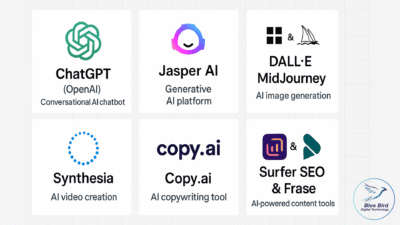
Grid of top Generative AI content creation tools with logos and names
Generative AI tools have become indispensable for content creators. Some popular platforms include:
1. ChatGPT (OpenAI):
-
Text generation, brainstorming, Q&A, email drafts.
-
Example: Creating entire blog posts or content outlines.
2. Jasper AI:
-
Marketing copy, blogs, social media posts.
-
Example: E-commerce websites generating product descriptions automatically.
3. DALL·E & MidJourney:
-
Image generation from text prompts.
-
Example: AI-designed ads or visuals for blog posts.
4. Synthesia:
-
AI video generation using avatars and scripts.
-
Example: Explainer videos, online courses.
5. Copy.ai:
-
Instant copywriting solutions for campaigns.
-
Example: Generating multiple ad variations for A/B testing.
6. Surfer SEO & Frase:
-
Optimizes content for search engines.
-
Example: AI-generated blog posts aligned with target keywords.
Generative AI Content Creation Impact on SEO and Digital Marketing
Generative AI has revolutionized digital marketing by helping businesses produce SEO-optimized and engaging content quickly.
SEO Benefits:
-
Automated keyword integration and density suggestions.
-
AI-driven meta titles, descriptions, and tags.
-
Topic suggestions based on search trends.
Marketing Advantages:
-
Personalized campaigns for diverse audience segments.
-
Data-driven content creation using AI analytics.
-
Social media posts, ad copy, and email newsletters created at scale.
Case Studies:
-
HubSpot: Uses AI to generate email campaigns, improving open rates by 30%.
-
Grammarly & Writesonic: Optimize blogs for readability and SEO simultaneously.
Image Suggestion: Bar graph showing AI-driven SEO improvements in traffic and engagement.
Challenges and Ethical Considerations in Generative AI Content Creation
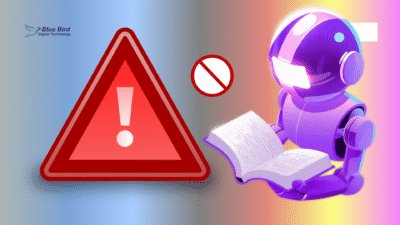
Warning symbol with AI and ethics icons
While AI is transformative, it brings risks and ethical concerns:
a. Plagiarism and Originality Issues:
AI can produce content similar to existing material. Creators must verify uniqueness using plagiarism checkers.
b. Bias in AI Models:
AI learns from historical data, which may contain bias. Careful supervision is needed to ensure fair and unbiased content.
c. Overreliance on AI:
Excessive dependence on AI may reduce human creativity. It’s important to maintain human oversight.
d. Legal and Copyright Concerns:
Ownership of AI-generated content is ambiguous. Platforms like OpenAI claim different usage rights, so creators must review terms of service.
The Future of Generative AI Content Creation
The future of content creation will be a collaborative ecosystem of humans and AI. Key trends include:
Hyper-Personalization:
AI will deliver tailored content to individual users based on preferences and behavior.
Multimedia Content Creation:
AI will generate text, images, videos, and even interactive experiences, reducing the gap between idea and execution.
Real-Time Content Generation:
AI will create live updates for news, sports, and interactive media.
Collaborative Creativity:
AI will become a creative co-pilot, helping humans iterate ideas faster while maintaining originality.
Case Study:
-
Netflix & Spotify: Already use AI to personalize user experiences, suggesting content based on behavior and preference.
The Bottom Line
Generative AI is transforming content creation, making it faster, more scalable, and highly personalized. While challenges like bias, plagiarism, and overreliance exist, the benefits far outweigh the risks. Content creators, marketers, and businesses that adopt AI early can stay ahead in the competitive digital landscape.
The key is to use AI as a collaborative tool, enhancing human creativity rather than replacing it. With AI-powered tools, the future of content creation is efficient, innovative, and limitless.


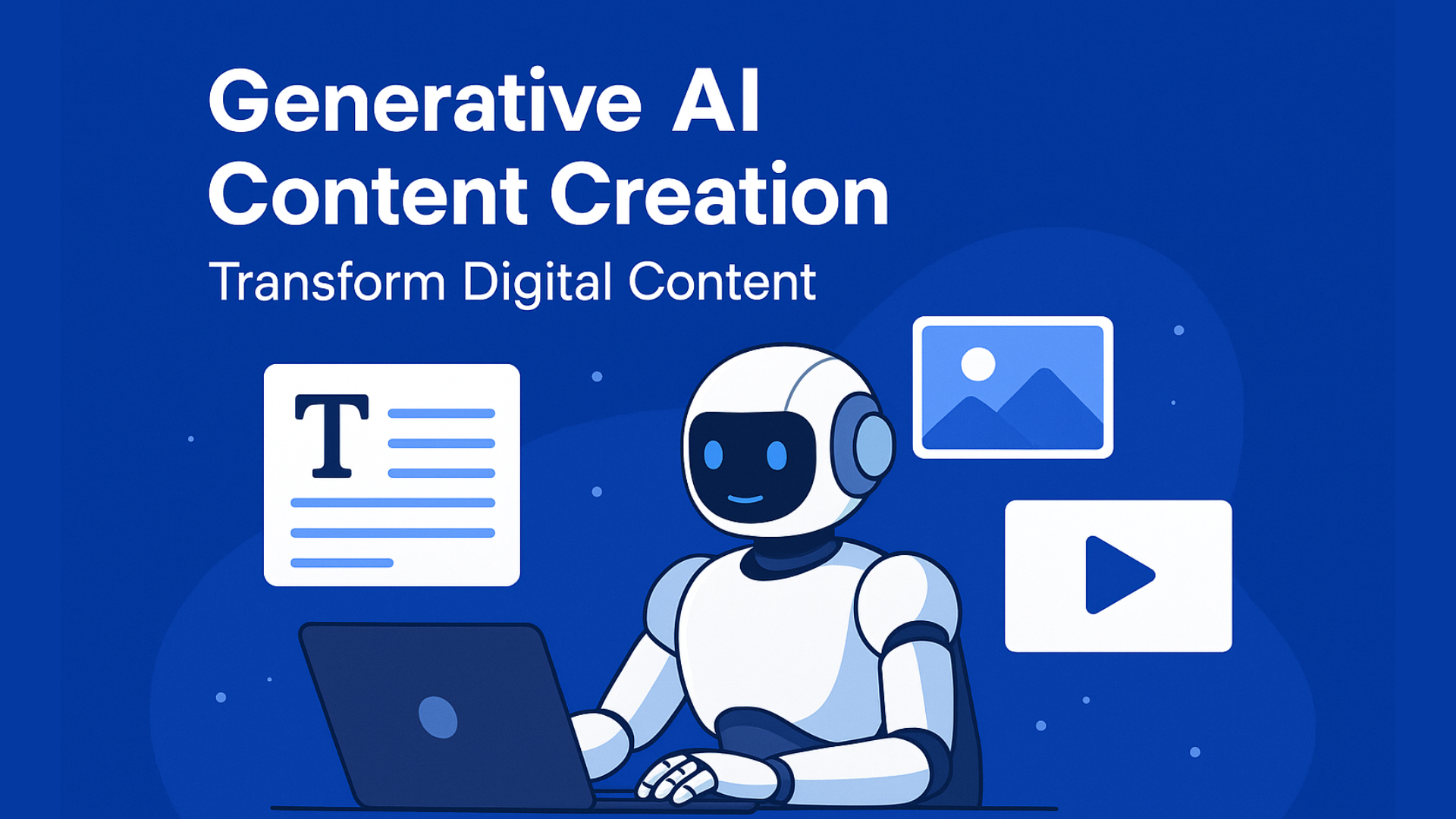
wow it’s a wonderful blog, i like this blog
thank you for reading